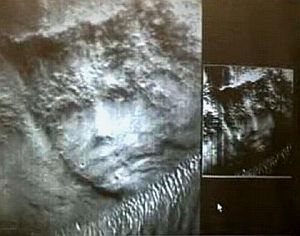

The HiRISE team has been documenting this smiley. The instrument transmits infrared laser pulses towards Mars at a rate of 10 Hz and measures the time of flight to determine the range of the MGS spacecraft to the Martian surface. So there’s a big search for that," says Dr Smith. But one major benefits of long-lasting spacecraft is being able to monitor changes in what is being observed. The Changing Face Of Mars MOLA is the Mars Orbiter Laser Altimeter, an instrument currently in orbit around Mars on the Mars Global Surveyor (MGS) spacecraft. "At some point we're going to have some people there and we’d like to know where the water is. PST at the California Institute of Technologys Beckman Auditorium in Pasadena. The camera on board MGS had to peer through wispy clouds to see the Face. 'The Changing Face of Mars' premieres tonight at 8 p.m. The Face on Mars is located at 41 degrees north martian latitude where it was winter in April 98 - a cloudy time of year on the Red Planet.
#THE CHANGING FACE OF MARS MOVIE#
23) to an audience in the Los Angeles area, and theres a chance the movie could eventually get distributed nationally. NASA's Mars rover Curiosity acquired this image using its Mars Hand Lens Imager (MAHLI), located on the turret at the end of the rover's robotic arm, on July 10, 2022, Sol 3528 of the Mars Science Laboratory Mission. NASA's Mars Reconnaissance Orbiter snapped photos of the poles, showing spiral patterns that helped scientists figure out what was going on. NASA is unveiling a new documentary film about the history of Mars exploration today (Jan. Written by Ken Herkenhoff, Planetary Geologist at USGS Astrogeology Science Center. The poles currently house about 87,000 cubic kilometres of ice, enough to cover the entire planet in ice 60cm deep. The current Mars ice age ended about 370,000 years ago, during the reign of Homo Erectus and the Neanderthals. "Because the climate on Mars fluctuates with larger swings in axial tilt, and ice will distribute differently for each swing, Mars would look substantially different in the past than it does now," says Dr Isaac Smith, researcher at the Southwest Research Institute in Texas. When the equator is closer to the sun, ice collects at the poles - which is what is happening now. When the poles are pointed at the sun, the ice melts redistributes toward the equator, causing an ice age. The temperature profile recorded during the hypersonic entry (solid line) and. This means its poles swing between angles of 10 and 40 degrees. In 2005 the Huygens probe entered Titans atmosphere and landed on its surface.


The Changing Face of Mars reveals, through archival footage and interviews with key scientists and engineers, JPL’s first roles in exploring the Red Planet, from Mariner 4, through the 1976 arrival of the Viking orbiters and.
#THE CHANGING FACE OF MARS FULL#
Mars on the other hand doesn't have a large moon to keep it steady so it wobbles greatly, pulled around by Jupiter. The data from Mariner 4, and from missions that followed, were full of confusing data for scientists to understand. NASA illustration of how Mars may have once looked (NASA)Įarth's tilt, which causes our seasons, is fairly stable at 23.5 degrees.


 0 kommentar(er)
0 kommentar(er)
